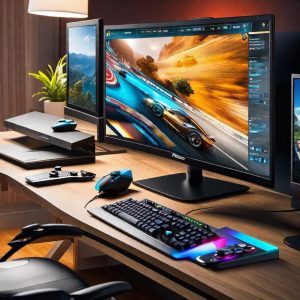
We’ve already written in one of our previous articles about how to assemble a PC correctly, but in fact, this whole topic has many questions and difficulties. Even experienced enthusiasts sometimes face similar mistakes. In this article, we’ll focus on how to avoid the most common mistakes when assembling a computer so that the whole system works stably and reliably from its very first start.
Choosing an insufficiently powerful power supply
The most common mistake is to choose a power supply with insufficient power. If the unit cannot provide stable power to all components, it will lead to unstable operation or even damage to the system. Instead of skimping, try using online calculators (search on Google) that will help you determine the exact power for your configuration, taking into account the margin.
Inappropriate housing
Choosing a case often seems simple, but not every case is suitable for a complex configuration with large graphics cards or advanced cooling systems. This can lead to problems with component installation or insufficient ventilation, for example. Make sure that the case you choose supports the form factor you need and has enough room for cooling.
Poor cable management
Messy cables not only make maintenance difficult, but also impair ventilation. Poor management often leads to overheating of the system. Use special channels and ties to organize the cables.
Incorrect use of thermal paste
Applying too much thermal paste will cause it to spread outside the CPU, which will impair heat dissipation and may even damage components. The correct approach is to use a small drop in the center, which will spread evenly when the cooler is installed.
Incorrect connection of power cables
It is not uncommon for users to forget to connect power to all components, resulting in an inability to start the system. Before turning on the computer, make sure that all necessary power cables are connected to the motherboard, processor, and graphics card.
Lack of antistatic protection
Important! Failure to use anti-static protection when working with sensitive components can result in damage. Even a small charge of static electricity can damage expensive parts. Therefore, we strongly recommend using antistatic wrist straps or at least making regular contact with the metal surface of the case…
Incorrect installation of RAM
Incorrectly inserted RAM can cause the system to not recognize it or not start at all. After installation, make sure that all the locks on the slots secure the memory modules.
Ignoring the cooling system
Lack of proper cooling is a common cause of system overheating. Poor cooling reduces component life and can lead to unstable performance. Proper airflow is the key to a healthy computer. Install additional fans or consider using liquid cooling if you have a powerful system.
Update the BIOS
Users usually ignore the need for BIOS updates. Modern motherboards require these updates in most cases to support newer processors. Check if there are any updates available for your board, and if so, install them.
No testing before final assembly
Another common mistake is that many people assemble a system completely and then find that some components do not work. In fact, assembling a computer without testing the main components at the initial stages leads to the need to disassemble the system if something is wrong. Before finalizing the assembly and organizing the cables, try connecting all the main components (processor, RAM, video card, drives) and test the system. If everything works, continue with the assembly. By avoiding these common mistakes, you will significantly increase the reliability and efficiency of your system. Remember: the right choice of components, attention to detail, and planning are the keys to creating a stable PC that will work smoothly for years to come. Take your time, check all the steps, and the result will definitely not disappoint you!

